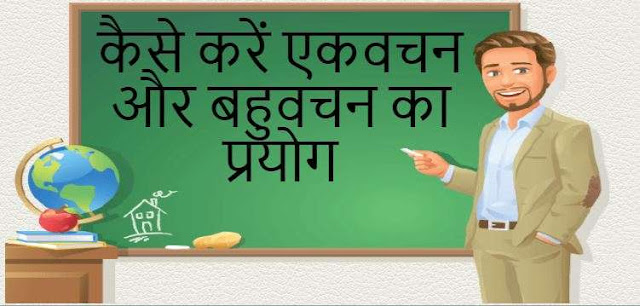कैसे करें एकवचन और बहुवचन का प्रयोग – Use of Singular And Plural Number in English Grammar
Contents
कैसे करें एकवचन और बहुवचन का प्रयोग – Use of Singular And Plural Number in English Grammar
Number -नंबर – वचन – वचन का प्रयोग किसी भी मनुष्य या किस वस्तु की गिनती (Counting)करने के लिए किया जाता है वचन दो प्रकार के होते है
Singular Number – सिंगुलर नंबर – एकवचन – जहाँ केवल एक मनुष्य तथा एक वस्तु के बारे में बताया जाता है वहां Singular Number (एकवचन ) होता है
- Example – Man,Boy,chair,Table,Book Etc
- Example – Men,Boys,chairs,Tables,Books, Etc
कोई
- Example
- Lady – लेडी – महिला
- Ladies – लेडीज़ – महिलाएं
स्वर Vowel आया हो तो वहां S लगा कर एकवचन से बहुवचन बनाया जाता हैं
- Example –
- Toy- टॉय – खिलौना
- Toys – तोयज़ – खिलौना
- Example –
- Day – डे – दिन
- Days – डेज़ – दिनों
F, Fe के स्थान पर Ves जोड़कर भी एकवचन से बहुवचन बनाया जा सकता है
- Example –
- Wife – वाइफ – पत्नी
- Wives वाइब्ज़ – पत्नियाँ
- Example –
- Hair – हेयर- बाल
- Sheep – शीप – भेड़
कुछ एकवचन जिनका अंतिम शब्द x,ch,ss,sh,s,o,z होता है वहां Es जोड़कर बहुवचन बनाया जाता है
- Example –
- Class- क्लास – कक्षा –
- Classes- क्लासेज – कक्षायें
- Example –
- Bench-बेंच- सीट
- Benches – बेंचज – सीटें
Use of Singular and Plural Number in English Grammar
In English grammar, number refers to the distinction between singular and plural forms. These forms are used to indicate whether we are talking about one thing (singular) or more than one thing (plural).
1. Singular Number (एकवचन)
-
Definition: A singular noun refers to one person, animal, thing, or concept.
-
Example:
-
Book (एक किताब)
-
Child (एक बच्चा)
-
Dog (एक कुत्ता)
-
Usage in Sentences:
-
I have a book. (मेरे पास एक किताब है।)
-
The dog is barking. (कुत्ता भौंक रहा है।)
2. Plural Number (बहुवचन)
-
Definition: A plural noun refers to more than one person, animal, thing, or concept.
-
Example:
-
Books (किताबें)
-
Children (बच्चे)
-
Dogs (कुत्ते)
-
Usage in Sentences:
-
I have many books. (मेरे पास कई किताबें हैं।)
-
The dogs are barking. (कुत्ते भौंक रहे हैं।)
General Rules for Forming Plurals
-
Adding “-s”:
For most nouns, simply add “s” to make them plural.-
Example:
-
Book → Books
-
Pen → Pens
-
Car → Cars
-
-
-
Adding “-es”:
If a noun ends in s, x, z, ch, or sh, add “es” to make it plural.-
Example:
-
Bus → Buses
-
Box → Boxes
-
Watch → Watches
-
Glass → Glasses
-
-
-
Changing “y” to “ies”:
If a noun ends in consonant + y, change the “y” to “ies”.-
Example:
-
Baby → Babies
-
City → Cities
-
-
-
Changing “f” or “fe” to “ves”:
Some nouns that end in “f” or “fe” change to “ves” in the plural form.-
Example:
-
Leaf → Leaves
-
Wolf → Wolves
-
Knife → Knives
-
-
-
Irregular Plurals:
Some nouns have irregular plural forms, where the change is not consistent with the rules above.-
Examples:
-
Man → Men
-
Woman → Women
-
Child → Children
-
Foot → Feet
-
Tooth → Teeth
-
Mouse → Mice
-
-
-
Same Singular and Plural Form:
Some nouns have the same form in both singular and plural.-
Example:
-
Deer → Deer
-
Sheep → Sheep
-
Fish → Fish (though fishes can be used when referring to different species of fish)
-
-
-
Compound Nouns:
In compound nouns, the plural is usually formed by changing the main noun in the compound.-
Example:
-
Passerby → Passersby
-
Attorney General → Attorneys General
-
-
Some Exceptions and Special Cases
-
Uncountable Nouns:
Some nouns are uncountable (e.g., water, rice, sugar), meaning they do not have a plural form.-
Example:
-
I need water.
-
There is no sugars in the bowl. (Incorrect)
-
-
-
Plural Forms for Collective Nouns:
Some collective nouns can have plural forms depending on whether you are referring to the group as a whole or individuals within the group.-
Example:
-
Team (singular) → Teams (plural)
-
Family (singular) → Families (plural)
-
-
Usage Examples of Singular and Plural in Sentences:
-
Singular:
-
I have one cat.
-
The child is playing outside.
-
This book is interesting.
-
-
Plural:
-
They have many cats.
-
The children are playing outside.
-
These books are interesting.
-
Conclusion:
Understanding the use of singular and plural numbers is crucial for forming correct sentences in English. Always remember to check the rules for regular and irregular plurals, as well as exceptions like uncountable nouns.
Let me know if you need more examples or any specific questions related to singular and plural forms!

